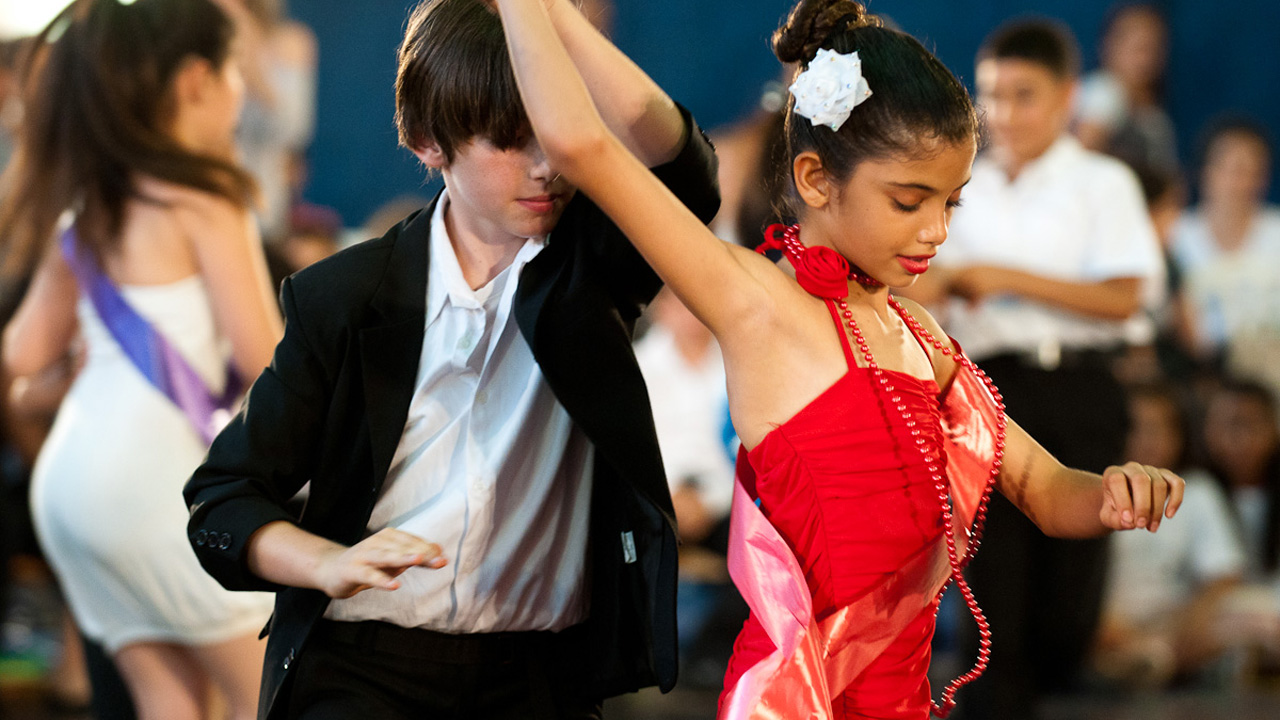
The Other Israel Film Festival, featuring films by and about Arab populations living in Israel, just finished running for its seventh season at the Manhattan Jewish Community Center. I was lucky enough to stream a few of the festival’s documentaries and dramas this week from my little corner of the West Coast. Two films impressed me the most, Dancing in Jaffa and The Lesson, both documentaries about complicated identities and their effect on self-esteem. Dancing in Jaffa is about Mad Hot Ballroom dance star Pierre Dulaine who was born in Jaffa in 1944, but left with his family shortly after the creation of the State of Israel in 1948. Decades later, he returns to his hometown with the dream of teaching young Israelis and Palestinians cooperation through ballroom dancing. Dulaine’s theory is that if you can instill self-confidence through an art form such as dance, trust in others will follow.
Dulaine shuttles us through Palestinian, Jewish, and mixed middle-school gyms in search of a group of kids who will be willing to dance with the enemy, so to speak. At first I thought his high glam personality and thick French accent would be too odd, and the dance form to stuffy, for the kids to relate to. He glides around his awkward students, playfully swatting them with his tie when they refuse to touch each other. He faces pushback from Muslim parents concerned that their sons and daughters will be holding hands. Some of the classroom scenes reminded me of my experience working as a full-time teacher this past summer. Like the moment the uneasy feeling set in that I couldn’t actually make the kids do anything, I’d have to persuade them. Dulaine learns to do just this, by sharing his personal story of growing up a shy Arab boy in Jaffa. Not so surprisingly, the students begin to open up, fighting to win the dance competition as if it were a free Xbox. You see, it doesn’t really matter what the craft is, kids like fun, connection, and facts about the world they don’t know yet. They aren’t actually as concerned with what’s new and edgy as the adults who create the games and cartoons have us believe. You can get them behind almost anything, even a ballroom competition.
One student, named Noor, has a mother who converted to Islam from Judaism in order to marry Noor’s father, who has recently passed away. We watch the twelve-year old girl bully her classmates only to later break down crying at her father’s grave after school. Through the course of the dance lessons, Noor transforms into an open, friendly, beautiful girl. At the end of the film, Dulaine visits Noor and her mother, who eggs her daughter on to dance Arab style for him. Noor’s neck instantly lengthens, her shoulders roll back, and she twists and turns; perfectly serene.
The Lesson is the story of an Egyptian-born woman in her sixties named Layla. A bride at fourteen, she followed her husband to Israel for business. There they became citizens, lived in a Jewish neighborhood in Bethlehem, and hid the fact that they were Muslim. Sixteen years later, Layla left her husband after he kicked her out on the street with their three children. Now in her sixties, Layla’s determined to get her driver’s license so that she can visit her old house in Bethlehem. After many failed attempts, she begins driving lessons with a Palestinian instructor named Nimar.
Watching her lessons, we learn that Layla is an unusual, fiercely independent woman. Not only did she leave her husband, she let her two daughters marry a Christian and Jew. She stares stubbornly ahead at the road as she admits to Nimar that she is lonely. Two out of three of her children never contact her, not even during Ramadan. Her thick Egyptian accent and solely Hebrew-speaking daughters set Layla apart from the rest of the Muslim Palestinian population. All her life, Layla served others and followed their troubles, now she wishes for peace. This means claiming her Muslim identity.
There are times when Layla’s story is interrupted by Nimar’s. It feels a bit out of place, like a singer suddenly plugging their CD. When Layla tries to drive into Bethlehem, she is stopped by a big sign. The area is governed by the Palestinian Authority. No Israeli citizens can enter. Layla looks confused. Nimar tells her what it means along with a little Palestinian history, which she must already be aware of having lived in Israel so long.
Regardless, Layla is somewhat of an outsider to both the Jewish and Arab communities. The truth is though, she is an independent fighter. What her story and Dancing in Jaffa demonstrate is that true identity is built on character. Sometimes we find ourselves on the periphery of society. We’re made to feel as though we don’t belong or are selfish for thinking differently. Identity is bigger than the society you live in, that spec of a place on the planet. It has to do with what you choose, to accept or reject. Layla and the families who agreed to participate in Dulaine’s ballroom competition are by no means the norm, but the brilliant exception.
Catie Damon is a recent graduate of UC Santa Cruz.
